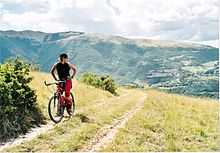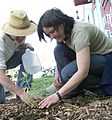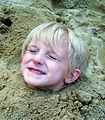Green exercise

| |
Resource type: this resource consists of notes. |
| |
Completion status: this resource is ~25% complete. |
There is growing interest in the potential physical and mental health benefits of green exercise (exercising in natural environments).
This page contains some research notes and summaries for those conducting or interested in green exercise research.
What is green exercise?
"Green exercise is activity in the presence of nature." (Barton & Pretty, 2010, p. 3947)
Green exercise is physical activities undertaken whilst exposed to natural environments (Pretty et al., 2005).
Green exercise, in its simplest form, is physical exercise performed in (relatively) natural environments (Mackay & Neill, 2010[1]; Neill, 2009[2]).

Examples of green exercise
-

Outdoor recreation activities e.g., Mountain biking and Cross-country running.
-
Water-based exercise activities e.g., Canoeing, Kayaking, Rafting, Sailing.
-

Gardening is one of the most popular forms of green exercise.
-

Sensual exploration of self in nature e.g., time at beach
-

Direct contact with nature exercises the sensory capacity, brain, and emotions e.g., outdoor play.
What does "green" really mean?
"Green" is a somewhat problematic term and interpretation of "green" warrants further consideration. "Green" is a proxy for "natural" - or the relatively absence of "artificial".
"Greenness" can be conceptualised and measured:
- Objectively: e.g., Sugiyama, Leslie, Giles-Corti, and Owen (2008) define “green” environments as vegetated areas such as parks, open spaces, and playgrounds.
- Subjectively: e.g., green exercise as exercise performed in environments with a greater ratio of natural to artificial elements than is typically encountered by that person in everyday life.
There is also the issue of green vs. natural. They do not always go together. Many natural environments are not green (and some artificial environments are green). Thus, the green in green exercise is not meant literarally, but rather figuratively to refer to naturalness (vs. artificialness) of an environment. Further conceptualisation and measurement of “greenness”, particularly as a psychological construct, however, remains underexplored (Bodin & Hartig, 2003).
Theory
Understandings of green exercise potential can potentially draw on and test aspects of several different theories including:
- Biophilia,
- Evolutionary psychology,
- Attention Restoration Theory
- Exercise psychology theories such as:
- Thermogenic hypothesis
- Cardiovascular conditioning
Research summary
University of Essex
The main researcher in the area of green exercise to date has been Professor Jules Pretty et al. at the University of Essex. The key studies are:
- Pretty et al. (2005)
- Pretty et al. (2007)
- Barton & Pretty (2010). [3]
- See http://greenexercise.org for a summary of their research work.
| “ | Recent research has investigated the effects on depression and overall mental health of exercising outside in a nature-based setting, such as a park—termed ‘green exercise’. Pretty et al. (2005), reporting on a study involving simulated green exercise (exercise on a treadmill while exposed to photographs of green spaces compared with other spaces), found that green exercise appears to have benefits both for cardiovascular health and mental health. A subsequent study by Peacock, Hine and Pretty (2007) compared exercising outdoors (in a ‘Country Park’) and exercising indoors (in a shopping centre). In comparison to the indoor exercise, the outdoor exercise was found to have more positive outcomes in terms of mood, and to be associated with an increase in the level of vigour or energy. | ” |
(p. 16, http://www.healthyparkshealthypeoplecongress.org/images/stories/documents/hphp.pdf.pdf)
| “ | Research conducted at the University of Essex identified four principal reasons why people enjoy green exercise:
|
” |
(Source: http://www.inneridea.com/library/news/body-mind-benefits-of-green-excercises)
University of Canberra
- Neill et al. - see http://wilderdom.com/wiki/James_Neill%27s_Publications_by_Topic#Green_exercise
- Mackay (2008) and Mackay and Neill (2010)
- Holgate (2010)
- Rugendyke (2012)
- Neill, Mackay, Holgate, & Rugendyke (2012)
Deakin
- See Townsend et al.
- Townsend, M. & Ebden, M. (2006). 'Feel Blue, Touch Green': Final report of a project undertaken by Deakin University, Barwon Helath, Parks Victoria, Alcoa Angelsea, ANGAIR and Surf Coast Shire. Retrieved from http://www.interenvironment.org/cipa/Feel%20Blue,%20Touch%20Green.pdf
QUT
- See Brymer et al.
- Brymer, E., Cuddihy, T. F., & Sharma-Brymer, V. (2010). The role of nature-based experiences in the development and maintenance of wellness. Asia-Pacific Journal of Health, Sport and Physical Education, 1, 21-28.
Research and discussion questions
A brainstorm of some possible research and/or discussion questions:
- What kind of green exercise do you participate in? Beach, parklands or forest | ability to take off shoes (earthing) | ability to focus on breathe (being present) | light to medium activity
- Type of activity? Beach or park walk | Yoga | kayaking or Paddle boarding
- Length of time? 30 minutes to 1 hours
- Location? Beach, parklands or forest
- Intensity? Light to medium intensity
- Alone or with others?More beneficial with social connection
- How "green" (natural) is the exercise? More green the better
- Is it informally or formally organised? Both
- What happens to you when you participate in green exercise? I feel healthier and happier and more connected with myself and nature.
- How does a green exercise experience differ (if at all) from physical exercise in non-natural environments? A feel better connected to myself, others and the environment around me.
- What do you like about green exercise? 'As above
- What do you not like about green exercise? Nothing
- How much green exercise would you ideally like to do? About 30 min to 1 hour daily
- What would be your 'ideal' green exercise experience? Paddle boarding in a National Park
- Is this a one off or a routine? No
- What enables green exercise? (Or when you do do green exercise, what makes this possible? (What are the enablers?)) Having the environment close to home.
- What are the barriers to green exercise? (Or If you don't do as much green exercise as you'd like to, why not? (What are the barriers?)) Not having a green space close to home120.151.31.17 (discuss) 18:59, 15 March 2016 (UTC)
References
- ↑ Mackay, G. J. S., & Neill, J. T. (2010). The effect of “green exercise” on state anxiety and the role of exercise duration, intensity, and greenness: A quasi-experimental study. Psychology of Sport and Exercise, 11(3), 238-245
- ↑ Neill, J. T. (2009). Green exercise: The psychological effects of exercising in nature. ORIC conference presentation. preparation.
- ↑ Barton, J. & Pretty, J. (2010). What is the best dose of nature and green exercise for improving mental health? A multi-study analysis. Environmental Science & Technology, .
Bratman, G. N. Daily, G. C., Levy, B. J., & Gross, J. J. (2015). The benefits of nature experience: Improved affect and cognition. Landscape and Urban Planning.
Hansmann, R., Hug, S., & Seeland, K. (2007). Restoration and stress relief through physical activities in forests and parks. Urban Forestry & Urban Greening, 6(4), 213-225. http://dx.doi.org/10.1016/j.ufug.2007.08.004.
Wooller, J. J., Barton, J., Gladwell, V. F., & Micklewright, D. (2015). Occlusion of sight, sound and smell during Green Exercise influences mood, perceived exertion and heart rate. International Journal of Environmental Health Research.
See also
- Green exercise (Wikipedia)
- Green exercise (Commons)
- Outdoor education
- Psychology of natural scenes
External links
- Green exercise research programme, University of Essex
- Jules Pretty
- Green exercise (James Neill, Wilderdom)
- Green exercise (Google search)